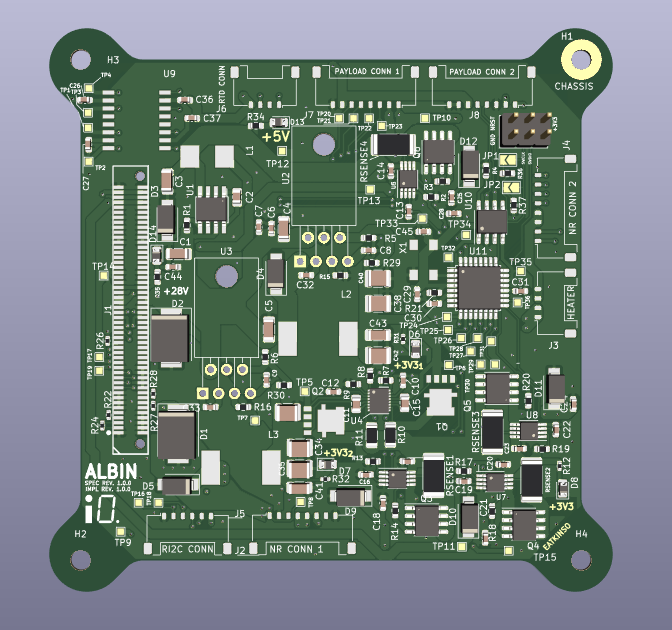
This winter, LASSI has been working hard to design hardware for SEAQUE, a quantum annealing and entanglement experiment led by Professor Paul Kwiat. To get the most bang for our buck when it comes to development money and engineering person-hours, much of the SEAQUE hardware has been developed according to the current IlliniSat-0 specifications -- this way, we can avoid wasting time on duplicate designs, and SEAQUE will ideally allow us to gain flight heritage before IlliniSat-0 flies.
ALBIN, or the Auxiliary Linked Bus INterface, is one example of SEAQUE hardware that will ideally play double duty as an early version of the IlliniSat-0 power board. ALBIN interfaces with the SEAQUE payload and control board through an IlliniSat-0 standard backbone connector and additionally complies with IlliniSat-0 electrical design standards and form factor.
To summarize the main functionality of ALBIN, it takes in a single supply voltage -- in this case, from the ISS, in the case of later revisions for IlliniSat-0, from the battery pack -- and converts it to appropriate supply voltages for the payload and other control and interface boards. Critical power rails are provided by redundant supplies and combined by a current-sharing regulator. ALBIN also regulates the current on every rail to prevent a fault on a single payload or board from damaging the rest of the system. An STM32 microcontroller monitors the status of, and sends necessary control signals to, the voltage regulators and current limiter ICs. The microcontroller also allows ALBIN to communicate with the rest of the system.
As with all space hardware, there are certain important aspects of the design that distinguish it from conventional power hardware. The (arguably) most important of these is that in space, nothing is air-cooled, so circuit designers must be especially conservative about heat. In the ALBIN render, you can see that many of the components seem very large -- this is because critical components were chosen to have current and power ratings significantly above the values ALBIN will likely encounter to ensure they can function in an environment with much poorer cooling than in a conventional device. Additionally, all of the power regulators are switching regulators to maximize efficiency and minimize excess heat dissipated in the regulators.
ALBIN, or the Auxiliary Linked Bus INterface, is one example of SEAQUE hardware that will ideally play double duty as an early version of the IlliniSat-0 power board. ALBIN interfaces with the SEAQUE payload and control board through an IlliniSat-0 standard backbone connector and additionally complies with IlliniSat-0 electrical design standards and form factor.
To summarize the main functionality of ALBIN, it takes in a single supply voltage -- in this case, from the ISS, in the case of later revisions for IlliniSat-0, from the battery pack -- and converts it to appropriate supply voltages for the payload and other control and interface boards. Critical power rails are provided by redundant supplies and combined by a current-sharing regulator. ALBIN also regulates the current on every rail to prevent a fault on a single payload or board from damaging the rest of the system. An STM32 microcontroller monitors the status of, and sends necessary control signals to, the voltage regulators and current limiter ICs. The microcontroller also allows ALBIN to communicate with the rest of the system.
As with all space hardware, there are certain important aspects of the design that distinguish it from conventional power hardware. The (arguably) most important of these is that in space, nothing is air-cooled, so circuit designers must be especially conservative about heat. In the ALBIN render, you can see that many of the components seem very large -- this is because critical components were chosen to have current and power ratings significantly above the values ALBIN will likely encounter to ensure they can function in an environment with much poorer cooling than in a conventional device. Additionally, all of the power regulators are switching regulators to maximize efficiency and minimize excess heat dissipated in the regulators.
